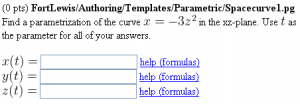Difference between revisions of "Spacecurve1"
Paultpearson (talk | contribs) |
(add historical tag and give links to newer problems.) |
||
| (4 intermediate revisions by 2 users not shown) | |||
| Line 1: | Line 1: | ||
| + | {{historical}} |
||
| + | |||
| + | <p style="font-size: 120%;font-weight:bold">This problem has been replaced with [https://openwebwork.github.io/pg-docs/sample-problems/Parametric/SpaceCurve.html a newer version of this problem]</p> |
||
| + | |||
<h2>A Parametric Curve in Space</h2> |
<h2>A Parametric Curve in Space</h2> |
||
| Line 6: | Line 10: | ||
</p> |
</p> |
||
* File location in OPL: [https://github.com/openwebwork/webwork-open-problem-library/blob/master/OpenProblemLibrary/FortLewis/Authoring/Templates/Parametric/Spacecurve1.pg FortLewis/Authoring/Templates/Parametric/Spacecurve1.pg] |
* File location in OPL: [https://github.com/openwebwork/webwork-open-problem-library/blob/master/OpenProblemLibrary/FortLewis/Authoring/Templates/Parametric/Spacecurve1.pg FortLewis/Authoring/Templates/Parametric/Spacecurve1.pg] |
||
| + | * PGML location in OPL: [https://github.com/openwebwork/webwork-open-problem-library/blob/master/OpenProblemLibrary/FortLewis/Authoring/Templates/Parametric/Spacecurve1_PGML.pg FortLewis/Authoring/Templates/Parametric/Spacecurve1_PGML.pg] |
||
<br clear="all" /> |
<br clear="all" /> |
||
| Line 15: | Line 20: | ||
<tr valign="top"> |
<tr valign="top"> |
||
| − | <th> PG problem file </th> |
+ | <th style="width: 40%"> PG problem file </th> |
<th> Explanation </th> |
<th> Explanation </th> |
||
</tr> |
</tr> |
||
| Line 42: | Line 47: | ||
loadMacros( |
loadMacros( |
||
| − | + | 'PGstandard.pl', |
|
| − | + | 'MathObjects.pl', |
|
| − | + | 'parserMultiAnswer.pl', |
|
| − | + | 'PGML.pl', |
|
| + | 'PGcourse.pl' |
||
); |
); |
||
| Line 102: | Line 107: | ||
<td style="background-color:#ffdddd;border:black 1px dashed;"> |
<td style="background-color:#ffdddd;border:black 1px dashed;"> |
||
<pre> |
<pre> |
||
| − | Context()->texStrings; |
||
| + | BEGIN_PGML |
||
| − | BEGIN_TEXT |
||
| + | Find a parametrization of the curve [` x = [$a] z^2 `] |
||
| − | Find a parametrization of the curve \( x = $a z^2 \) |
||
| + | in the [`xz`]-plane. Use [` t `] as the |
||
| − | in the \(xz\)-plane. Use \( t \) as the |
||
parameter for all of your answers. |
parameter for all of your answers. |
||
| − | $BR |
||
| + | |||
| − | $BR |
||
| + | - [` x(t) = `] [______________]{$multians} |
||
| − | + | - [` y(t) = `] [______________]{$multians} |
|
| − | + | - [` z(t) = `] [______________]{$multians} |
|
| − | + | ||
| − | + | [@ helpLink('formulas') @]* |
|
| − | + | END_PGML |
|
| − | $BR |
||
| − | \( z(t) = \) \{$multians->ans_rule(20)\} |
||
| − | \{ AnswerFormatHelp("formulas") \} |
||
| − | END_TEXT |
||
| − | Context()->normalStrings; |
||
</pre> |
</pre> |
||
<td style="background-color:#ffcccc;padding:7px;"> |
<td style="background-color:#ffcccc;padding:7px;"> |
||
<p> |
<p> |
||
<b>Main Text:</b> |
<b>Main Text:</b> |
||
| − | Notice that we use <code>$multians |
+ | Notice that we use <code>$multians</code> in each answer blank because they results in the three answers are dependent on each other. |
| − | </p> |
||
| − | </td> |
||
| − | </tr> |
||
| − | |||
| − | <!-- Answer evaluation section --> |
||
| − | |||
| − | <tr valign="top"> |
||
| − | <td style="background-color:#eeddff;border:black 1px dashed;"> |
||
| − | <pre> |
||
| − | $showPartialCorrectAnswers = 0; |
||
| − | |||
| − | ANS($multians->cmp()); |
||
| − | </pre> |
||
| − | <td style="background-color:#eeccff;padding:7px;"> |
||
| − | <p> |
||
| − | <b>Answer Evaluation:</b> |
||
</p> |
</p> |
||
</td> |
</td> |
||
| Line 128: | Line 132: | ||
<td style="background-color:#ddddff;border:black 1px dashed;"> |
<td style="background-color:#ddddff;border:black 1px dashed;"> |
||
<pre> |
<pre> |
||
| − | Context()->texStrings; |
||
| + | BEGIN_PGML_SOLUTION |
||
| − | BEGIN_SOLUTION |
||
Solution explanation goes here. |
Solution explanation goes here. |
||
| − | END_SOLUTION |
||
| + | END_PGML_SOLUTION |
||
| − | Context()->normalStrings; |
||
| − | |||
| − | COMMENT('MathObject version.'); |
||
ENDDOCUMENT(); |
ENDDOCUMENT(); |
||
Latest revision as of 07:50, 18 July 2023
This problem has been replaced with a newer version of this problem
A Parametric Curve in Space
This PG code shows how to ask a parametric curve question with three answer blanks and use MultiAnswer to check the answer.
- File location in OPL: FortLewis/Authoring/Templates/Parametric/Spacecurve1.pg
- PGML location in OPL: FortLewis/Authoring/Templates/Parametric/Spacecurve1_PGML.pg
| PG problem file | Explanation |
|---|---|
|
Problem tagging: |
|
DOCUMENT(); loadMacros( 'PGstandard.pl', 'MathObjects.pl', 'parserMultiAnswer.pl', 'PGML.pl', 'PGcourse.pl' ); TEXT(beginproblem()); |
Initialization:
Since we will have multiple answer blanks that depend on each other, we need to use |
Context("Numeric");
Context()->variables->are(t=>"Real");
Context()->variables->set(t=>{limits=>[0,10]});
$a = random(-5,-2,1);
$x = Formula("$a * t**2");
$y = Formula("0");
$z = Formula("t");
$multians = MultiAnswer($x, $y, $z)->with(
singleResult => 1,
checker => sub {
my ( $correct, $student, $self ) = @_;
my ( $xstu, $ystu, $zstu ) = @{$student};
return 0 unless $xstu->isFormula;
if (($xstu==$a*$zstu**2) && ($ystu==0)) {
return 1;
} else {
return 0;
}
}
);
|
Setup:
We use |
BEGIN_PGML
Find a parametrization of the curve [` x = [$a] z^2 `]
in the [`xz`]-plane. Use [` t `] as the
parameter for all of your answers.
- [` x(t) = `] [______________]{$multians}
- [` y(t) = `] [______________]{$multians}
- [` z(t) = `] [______________]{$multians}
[@ helpLink('formulas') @]*
END_PGML
|
Main Text:
Notice that we use |
BEGIN_PGML_SOLUTION Solution explanation goes here. END_PGML_SOLUTION ENDDOCUMENT(); |
Solution: |
